
Search
The Renewable Energy site for Do-It-Yourselfers
Space Heating Performance for
Sunspace/Greenhouse -- Not Optimized
|
This test using the Montana Experimental
Solar Structure (MESS -- got to have an acronym :) looks
at using the MESS to simulate a sunspace attached to a house for the
purpose of providing space heating to the house. While the MESS is
not actually attached to my house, I do like the idea of using a low
thermal mass sunspace to heat a house.
There is not much actual performance data for heating with sunspaces,
and thought this test might be helpful for those trying to figure out
how much heat they might get from a sunspace.
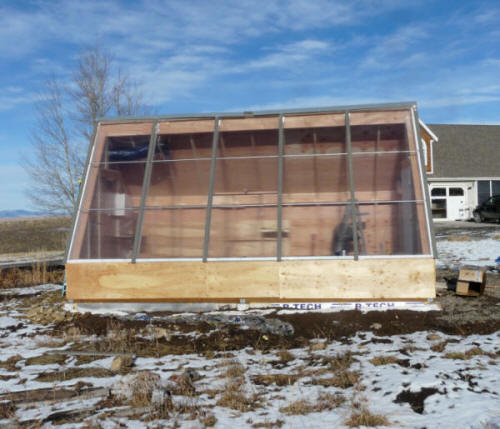
This first test looks at the sunspace that has not been optimized for
space heating. The next test will see if some optimizations can
improve the performance. If you have a sunspace
how about taking some measurements and send them in -- I can help you
with what to measure if you are uncertain. |
|
Configuration for Non-Optimized Test
Ideally, an attached sunspace or greenhouse that is used primarily to provide
solar heat to the attached house would have these features:
- Large area of south facing glazing at a steep tilt angle for good solar
heat collection.
- Low thermal mass so that the heat is sent to the house rather than
warming sunspace thermal mass.
- Insulated east, west, and north walls and insulation on any non-glazed
ceiling areas to reduce heat loss to the outdoors.
- An insulated floor so that the floor does not absorb solar energy.
- A heat distribution system (fan and ducting) that removes hot air from
the sunspace as quickly as it is made and returns cool room air to the
sunspace.
The idea of all these features is to harvest as much of the sunspace heat as
possible for use in the house rather than having it go into heating the sunspace
or greenhouse.
This first stage in the testing measures how much heat the sunspace can
produce when some of these rules are not followed. The idea is to see what
you lose by not observing all the rules. The test green does follows rules
1 (large glazed area), rule 2 (low thermal mass), and rule 5 (a fan to remove
heat as quickly as its made). It does not follow rule 3 (no insulation on
walls or ceiling), and does not follow rule 4 (the floor is just bare dirt with
no insulation).
A latter test will look at the performance after adding wall and ceiling
insulation and floor insulation to see how much difference it makes.
There are two weaknesses in using this freestanding greenhouse to model an
attached sunspace:
- The inlet air for the sunspace is just outdoor ambient
air instead of being air returned from the house being heated by the sunspace.
Since the sunspace is freestanding, it was not possible to pull the inlet air
from the house. I may try to work out a solar preheater for the inlets on
the next test. One result of the colder inlet air is that the
collector operates a little more efficiently because the losses out the glazing
are reduced.
- If this were an attached sunspace, its likely that only
the south half would be used, and this would be placed directly against the side
of the house, with the house wall forming the north wall of the sunspace.
This would eliminate the heat loss from the whole back of the greenhouse, which
is significant (see below) for this uninsulated version. One of the
advantages of an attached sunspace is that the shared wall with the house helps
both structures from a heat loss point of view.
Some pictures of the sunspace/greenhouse as it was for the test:
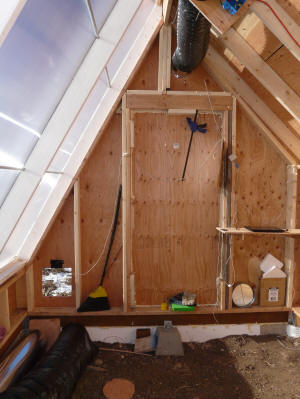
Looking west inside the sunspace. |
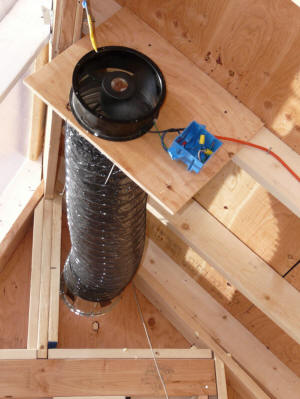
sunspace exhaust fan near peak |
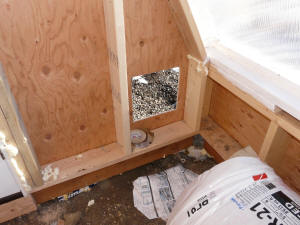
Inlet vent is currently just two 1 ft square
openings to the outside
on the east and west walls. |
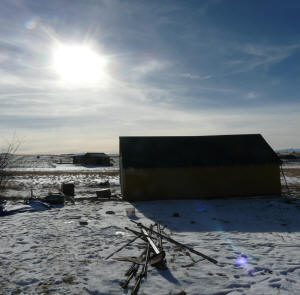
Sun conditions for the test. |
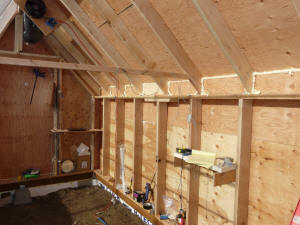
pretty well sealed, but no insulation. |
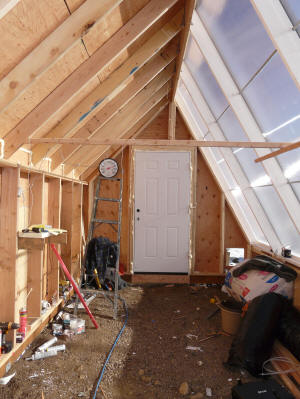
Looking east. |
Space Heating Performance
This is the performance plot for November 28, 2012 with the
greenhouse/sunspace in the configuration shown above (non-optimized).
Temperatures at the inlet, outlet and at several points in the structure were
logged along with solar intensity.

Red Solid -- Space heating outlet temperature (F)
(exhaust fan inlet temperature)
Blue Dash -- Greenhouse inlet temperature (F)
Green Dash -- Ambient temperature (F) (measured
outside the north wall)
Aqua Dash-Dot -- Temperature 1 ft above floor near
west end (F)
Yellow Green Solid -- Solar radiation on glazing surface
(watts/sm)
Purple Dash-Dot -- Temperature at peak near east end (F)
Purple Solid -- Temperature near center of space at 6 ft
above floor (F)
The sun around noon was good at about 1100 w/sm -- this is measured in the
plane of the glazing and includes snow reflection. There was a faint but
visible cloud layer in front of the sun much of the day. By about 1pm the
clouds had increased and the sun level dropped to about 750 w/sm. The sun
measurements were taken with an Apogee pyranometer mounted in the glazing plane.
Its interesting to the note that the fan inlet temperatures averaged 15 to
20F lower than the peak temperature and also lower than the temperature at 5 ft
off the floor. So, perhaps a better way is needed to pull the hot air out
of the peak across the full width? Not sure where the cooler air that is
finding its way to the fan inlet is coming from?
During the highest sun periods, the sunspace heated the air from about 43F up
to 83F, or about a 40F warmup -- probably about the right amount of heating.
If the inlet air had been 60F room air, then the exit air would have been closer
to 100F, which seems about right.
Later in the day, when the sun dropped to about 700 w/sm, the air was warmed
from about 46 F up to about 76F, or about 30F. This is when a
variable speed fan that could drop the flowrate a bit to allow for more
temperature rise might be nice.
Velocity and Flow
The exit vent velocity was measured several times during the test and ranged
from 630fpm in the early part of the testing (noon) up to about 685 fpm at 2 pm.
The flow is measured in a 10 inch duct with an area of 0.55 sf. This gives
an exit flow rate of about 350 cfm to 375 cfm.
The velocities at the inlets were also measured at around 200 fpm. Each
inlet is 1 sf, so the flow rate calculated using the center of inlet velocities
would be 400 cfm -- more than the exit flow. I attribute this to a fall
off toward the edges of the square inlet openings.
The flow rate is about 350 cfm and the volume of the space is about 1400 cf,
so it takes about 4 minutes to introduce enough new air through the inlets to
fill the space.
The flow rate per sqft of glazing is about 350/200 = 1.8 cfm per sqft.
This is a bit lower than what is typically used for good performance in an
active collector.
Floor and Wall Temperatures
I checked the dirt floor temperatures several times both in the sunlit areas
and the shaded areas. The results were a bit surprising.
The sunlit floor near the north wall started at about 97F just as the fan was
turned on to start the test, and dropped to mid 70's as the test was going.
It reached about 60F by the end of the test. So, it appears that there
even though there was good sunshine directly on the dirt floor, there was enough
airflow over the dirt to drop the temperature of the floor during the test.
The shaded floor just north of the low south wall was about 59F at the start
of the test, and dropped down to the 36 to 40F range. I believe that this
was the influence of the cold air streams coming into the inlet vents located
low in the east and west walls near the south wall. That is, the cold vent
air flows tracked low along the south wall cooling the floor.
All of the floor temperatures were just surface temperatures -- I did not see
what was happening a ways down into the dirt.
The back wall temperature behaved similarly, stating at around 99F and
dropping down to 60 to 75F during the test. Again, the airflow
appeared to cool the back wall once the fan was going.
Living in Your Collector
Since one good reason to build a sunspace is to have a nice place to spend
some time, I'll pass on some experiences from spending time in mine.
Without the fan running, the space can be quite hot -- up to 120F and more.
Not a space you would like to spend much time. But, a good space for doing
laundry or installing a solar water heater.
With the fan removing heat the sunspace can be quite comfortable. The
temperatures drop down into the nice range, its brightly lighted, there is just
a bit of air current, which feels good. It would be a great place to
have a cup of coffee and read the paper -- something you can't say about the
inside of most solar collectors.
The fan I am using is a
Dayton 10 inch 600 cfm fan from Grainger. Its pretty quiet, but
still too noisy to live with if its mounted right in the sunspace.
It might do better with some kind of isolated mount. I think that choosing
a quiet fan that produces the right amount of airflow is something that deserves
a lot of attention in sunspace design.
Contrast to Active Collector
In this application, the sunspace is being used as an alternative to a
conventional solar air heating collector to provide space heating.
Its interesting to note some of the contrasts.
- The flow velocities are much lower in the sunspace -- in most places I
can't measure them with a good air velocity meter and you really can't feel
them, but in a conventional collector, air velocities are fairly high -- up
toward 100 fpm.
- In a conventional collector, there is usually a significant air velocity
along the glazing, where as in the sunspace its too small to measure.
- The surfaces that absorb the solar radiation are spaced further from the
glazing, are larger, and run cooler.
- The flow pattern in a conventional collector can (it seems) be
controlled more precisely with channels, baffles, screens, ... than for a
sunspace.
- The sunspace has more outer heat loss area and more potential leakage
area.
Items 1 through 3 would seem to me to favor the sunspace as an efficient heat
collector with low losses?
Items 4 and 5 would seem to favor the conventional collector?
IR Pictures
Thermal camera pictures of the glazing from outside and inside during the
test at around noon.
At the time these images were taken, temperatures were: Peak of GH 95F, at 6
ft near center 95F, ambient 45F, Inlet air 45F.
Smoke Test
A smoke test was done to have a look at airflow patterns. The 90 second
smoke pellet was placed in the East inlet vent with the fan operating.
The inlet where the smoke pellet was ignited is low in the east wall near the
south glazing (pictures above). The smoke rushed into the inlet and
proceeded west staying low and moving quickly. As it approached the middle
of the front wall of the GH, it encountered the stream of inlet air from the
west vent and this caused it to spread out and slowly move upward -- it did not
penetrate the air stream from the west inlet at all. Over some time
(3 minutes?) the smoke spread out horizontally and then upward in what seemed
like a fairly slow and diffuse way. It basically filled the whole GH
with a diffuse smoke that gradually made its way up to the peak and then out the
fan.
The flow rate is about 350 cfm and the volume of the space is about 1400 cf,
so it takes about 4 minutes to introduce enough new air through the inlets to
fill the space.
Velocity Survey
I walked the GH with a hot wire anemometer trying to get an idea where the
air currents were flowing. Basically the air currents in nearly all of the
GH were too low (less than 2 fpm) to measure with the anemometer. The
exceptions were within about 4 ft of the inlets and the exit fan.
So, any flow channels or paths that exist are too low in velocity to detect with
the hot wire anemometer.
Next time I will see how the smoke pencil does on seeing where the air is
flowing.
Performance
Some rough estimates of heat output and even rougher estimates of efficiency.
Looking at 12:30 pm
Solar input = (1080 w/sm)(200 sf)(1 sm/10.76sf) (3.412
BTU/h / watt) = 68500 BTU/hr
Heat output = (350 cf/min)(0.062lb/cf)(81.6F - 43.8F)(60
min/hr)(0.24 BTU/lb-F) = 11800 BTU/hr
An implied rough effic of = (11800 BTU/h)/(68500 BTU/h) =
17%
At 1:30 pm
Solar input = (770 w/sm)(200 sf)(1 sm/10.76sf) (3.412
BTU/h / watt) = 48800 BTU/hr
Heat output = (375 cf/min)(0.062lb/cf)(76.3F - 46.4F)(60
min/hr)(0.24 BTU/lb-F) = 10000 BTU/hr
An implied rough effic of = (10000 BTU/h)/(48800 BTU/h) =
20%
So, around 20% efficiency is not is not exactly stellar, but 12,000 BTU/hr
from a modest sized sunspace is definitely a useful amount of space heating.
Just for comparison, its about equivalent to a 4000 watt PV array at the STC
rating.
I expect that once the sunspace is optimized for heating in the next test it
will do better.
In the
screen absorber collector testing that Scott and I did last year, the sunny
winter day efficiencies were in the 40% ballpark.
Next Test
For the next test, I will insulate the floor and also insulate all wall and
the north ceiling. I'll repeat the same sort of test and see how
much difference it makes.
I am inclined to think that the difference will be significant.
The sun shining directly on the dirt floor as it does now should result in a
significant fraction being absorbed directly by the ground and not getting to
the "house". For the insulation, the total area to be insulated is about
300 sf. If you assume that the average inside temperature is 70F and
outside is 30F, and that the current plywood walls are R1, then the heat loss is
(300sf)(70F - 30F)/(R1) = 12,000 BTU/hr. The total solar incident on
the 200 sf of glazing is about 60000 BTU/hr, and you would expect to only
harvest about half of that in a good collector, so the 12K BTU/hr is a
worthwhile fraction of that.
I guess we will see.
If you have any ideas or suggestions, please leave a
comment on this page....
November 28, 2012
Gary



